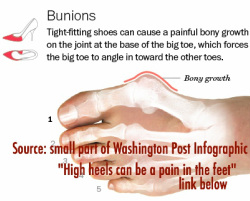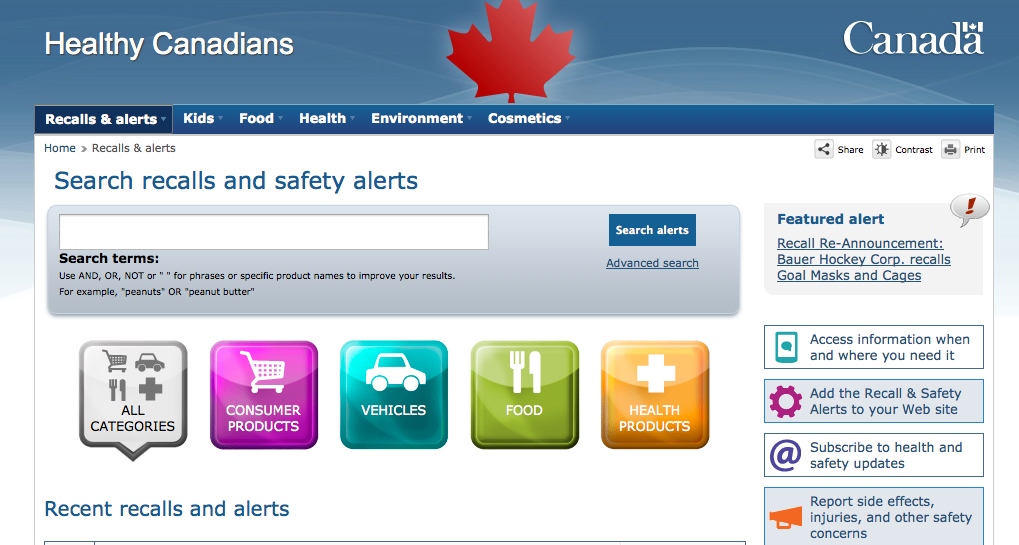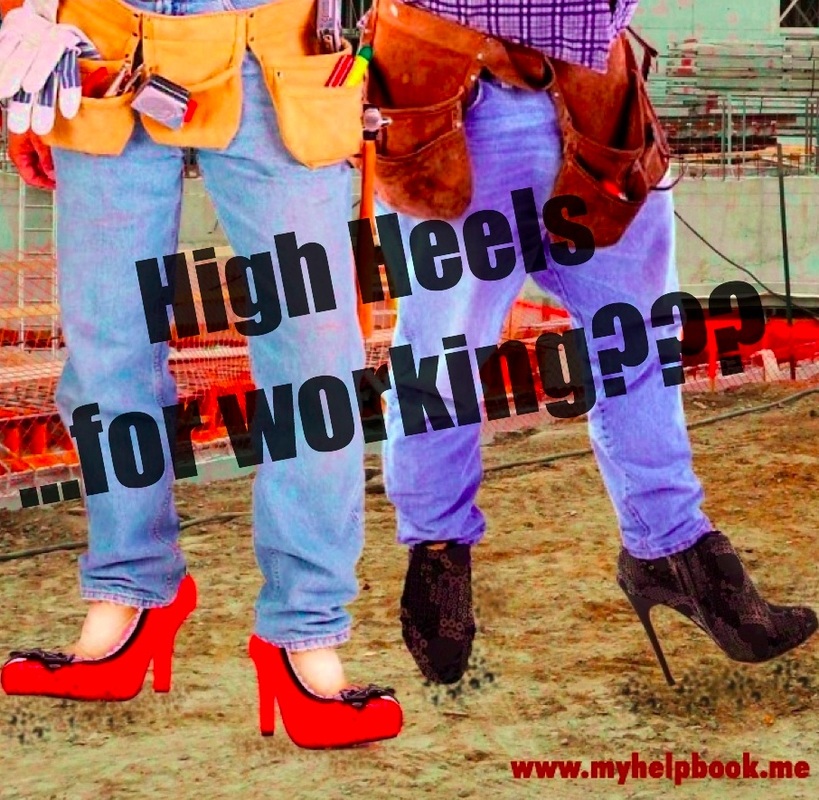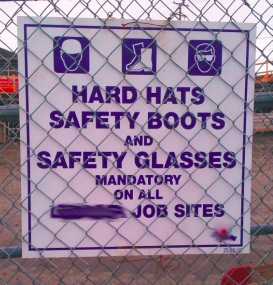|
Canadian (and BC) consumer safety and recall information websites:
GetPrepared.gc.ca Emergency preparedness info HealthyCanadians.gc.ca Product recalls, children’s health, food safety and more CanadaSafetyCouncil.org Safety information on many topics Preventable.ca Promoting safety; preventing injuries; education and information ParachuteCanada.org Home safety tips for parents; preventing injuries, saving lives SafetyAuthority.ca Utilities safety, plus safety information & training Office of Consumer Affairs - Industry Canada ConsumerHandbook.ca - Canadian Consumer Handbook (customizable) ConsumerInformation.ca Recalls and more from Industry Canada ConsumerProtectionBC.ca ---1-888-564-9963 Information, services, news & more Consumers Association of Canada Education & advocacy on marketplace issues ConsumerDangers.com (US-based) Consumer protection and recall information BC Motor Vehicle Sales Authority ---1-877-294-9889 Information & complaints DriveSmartBC.ca BC-focused community website on traffic law and road safety MyCarDoesWhat.org Information on new vehicle safety technology RVsafety.com Recreational vehicle safety & training LifeSaving.bc.ca (BC Yukon Branch) Water safety & lifeguard training Canadian Safe Boating Council Safety information & outreach Canadian Office of Boating Safety (Transport Canada) Info, education & regulations Transport Canada Safety info for all transportation topics (including regulation of drones) From the Safety and Consumer Sections of My Help Book BC 2016
1 Comment
Carbon Monoxide is called "the silent killer" because it is a colourless and odorless gas that can be fatal in just a few minutes at high concentrations. (from My Help Book BC)
CARBON MONOXIDE (CO) SAFETY STAY SAFE – get a CO detector for your home, RV or camper. Anyone with fuel-burning or gas appliances needs linked CO alarms near furnace, bedrooms and on each floor. Learn what your CO alarm sounds like and what to do if it goes off. Keep track of when you need to replace it, keep it clean, make sure it has fresh batteries, and follow other important instructions. Get a quality certified unit. In one tragedy an entire Ontario family died because they did not have a CO monitor (CBC News). In the U.S. (2015) a slumber party fell ill due to a faulty furnace. And in the Yukon (2015), a faulty propane refrigerator would have created a tragedy if not for a CO monitor. POTENTIAL SOURCES OF CO EXPOSURE: Furnaces, gas & kerosene space heaters, boilers, gas stoves, gas water heaters, gas clothes dryers, gas fireplaces, charcoal grills, wood stoves, camp stoves, vehicles, boat exhaust, lawn mowers, generators, power tools with internal combustion engines; propane- powered vehicles. Learn signs of CO problems in the home from the BC Safety Authority website. STAY SAFE... Indoors and enclosed spaces:
Vehicles:
Home heating:
If exposed to high concentration, a victim may pass-out with no symptoms in a few minutes. CO EXPOSURE EMERGENCY: Get everyone outside and call 911. Get medical attention. Let them know it may be CO poisoning. CO EXPOSURE NON-emergency (if no one is experiencing symptoms of CO poisoning): Shut off fuel-burning or gas appliances; call your gas company; get a qualified professional to check & fix problem. See a doctor, let them know you have had CO exposure. On-going low CO exposure is bad for health, especially for vulnerable people. What are signs of on-going low CO exposure?
LEARN MORE CO Safety Information:Examples of CO poisoning in the news  IMPORTANT UPDATES - LAWS CHANGED IN 2017 2018 - Alberta employers no longer allowed to mandate high heels in the workplace. 2018 - (BC) Restaurant workers choosing sneakers over high heels. "I’m surprised it took so long for this law to be put into effect." 2017 - BC Bans mandatory high heeled shoes in workplaces. "...there is also a positive human rights consideration addressed by the changes given that men are typically not subjected to the same uncomfortable footwear expectation." 2017 - BC amends footwear regulations. Employers can no longer force workers to wear footwear with a design, construction or material that inhibits the worker's ability to safely do their job. In addition, employers must consider slipping, ankle protection, foot support, muscle or bone injuries, and electrical shock when considering mandatory footwear. New Worksafe BC rules: https://www.worksafebc.com/en/health-safety/education-training-certification/apprenticeship-programs/trades-topics/footwear LAWS HAVE BEEN CHANGED - ARCHIVED INFO BELOW - NEW INFO ABOVE 2014 - Some restaurants and other facilities have minimum heel heights for their female serving staff even though working in high heels can cause serious foot, ankle, knee and back problems. High heels are designed for fashion, not work-place safety. Consider: if carriage horses had to wear painful horse shoes causing injury and disability, there would be outrage, boycotts and animal cruelty charges. Women working on their feet all day in high heels should be viewed with the same alarm as if we saw construction workers wearing high heels on a job site. This is what Worksafe BC regulation 8.22 says about safe footwear in the workplace: "A worker's footwear must be of a design, construction, and material appropriate to the protection required [taking into consideration] slipping, uneven terrain, abrasion, ankle protection and foot support, crushing potential, temperature extremes, corrosive substances, puncture hazards, electrical shock and any other recognizable hazard." Read full Worksafe BC 8.22 regulation. Employers must also take into account their workers safety under Division 3-115 of the BC Worker's Compensation Act: "General duties of employers 115 (1) Every employer must (a) ensure the health and safety of (i) all workers working for that employer" If restaurants refuse to follow Worksafe regulations to protect women servers from injury and prevent long term disability and health problems, this means any employer is free to ignore any safety regulation whenever it suits them. There are many hazardous jobs, but health and safety regulations aim to minimize those hazards, often by prescribing protective clothing or equipment. Requiring female serving staff to wear dangerous, painful and injurious footwear does exactly the opposite: it maximizes the potential for hazard and harm. Falling down stairs while carrying heavy plates of food should not be considered a normal part of anyones workday. High heels are such an obvious work hazard that only a sadist could fail to recognize this. In what other job are workers purposely put in pain while also expected to smile and act cheerful? "Pointed toes and high heels are particularly inappropriate for working footwear." Government of Canada, Canadian Centre for Occupational Health and Safety Fact Sheets. High heels cause and contribute to the following conditions:
Conclusion: Harm from heels is minimized and is thought of as being an acceptable risk -- especially because high heels are a popular fashion fad for women even though heels were originally only worn by only men and after that by women to show they were a member of the leisure class (2). However, harm from heels should not be thought of as an acceptable workplace risk, not just because it violates and make a joke of work safety regulations, but because the harm can accumulate slowly. After working for a certain number of hours wearing heels, it is certain there will be a loss of function in your feet, ankles, knees or back. Loss of mobility has serious long term impacts but young women when they are thinking about the need for income to pay off student loans, or providing income for their children, cannot afford to worry about long term costs to their health and mobility. And if they are aware of the harm, as Amy Tuckett states in her interview about this issue, "servers don't want to stir anything up or they may be fired." (1) The question that needs to be asked: If health and safety regulations for women servers are ignored, should all health and safety regulations be ignored? And second: What century are we in? More information on this issue:
BC Ministry of Labour Restaurant Employees Fact Sheet regarding:
Related Links:
Quotes from online discussion on restaurant clothing and footwear requirements: "[Two] girls just went to the labour board because they were discriminated against for getting pregnant and no longer meeting “uniform standards”. The uniform in the lounge is completely different from the dining room. Girls in the lounge are required to wear at least a 2 inch heel and now the management is cracking down on the width of the heels. Now they prefer them to be the slender, almost stiletto type of heel because the thicker, more comfortable heel isn’t as ‘classy’. A lounge server told me a couple days ago that she was taking advil during her shift because her feet hurt so much." |
AuthorMy Opportunity & Help Book BC Categories
All
Archives
December 2020
|
Proudly powered by Weebly




 RSS Feed
RSS Feed